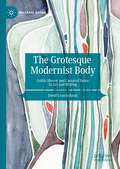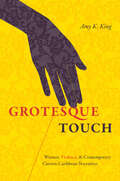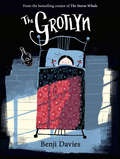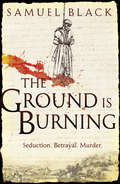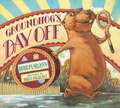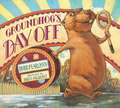- Table View
- List View
Großer Mann im seidenen Rock: Heines Verhältnis zu Goethe. Mit einem Essay von Jost Hermand. Heinrich-Heine-Institut Düsseldorf: Archiv, Bibliothek, Museum, 8
by Ursula Roth Heidemarie VahlDer vorliegende Band, der als Begleitpublikation zu einer Ausstellung des Düsseldorfer Heine-Museums zum Goethe-Jahr 1999 erscheint, enthält neben einer umfangreichen Bilddokumentation zum Verhältnis der beiden Dichter Heine-Äußerungen über Goethe, Urteile der Nachwelt, kontrastive Originaltexte von Goethe und Heine sowie weiterführende Materialien und Kommentare.
Grotesque (Vintage International Series)
by Natsuo KirinoTwo prostitutes are murdered in Tokyo.Twenty years previously both women were educated at the same elite school for young ladies, and had seemingly promising futures ahead of them. But in a world of dark desire and vicious ambition, for both women, prostitution meant power. Grotesque is a masterful and haunting thriller, a chilling exploration of women's secret lives in modern day Japan.
Grotesque Figures: Baudelaire, Rousseau, and the Aesthetics of Modernity (Parallax: Re-visions of Culture and Society)
by Virginia E. SwainCharles Baudelaire is usually read as a paradigmatically modern poet, whose work ushered in a new era of French literature. But the common emphasis on his use of new forms and styles overlooks the complex role of the past in his work. In Grotesque Figures, Virginia E. Swain explores how the specter of the eighteenth century made itself felt in Baudelaire's modern poetry in the pervasive textual and figural presence of Jean-Jacques Rousseau. Not only do Rousseau's ideas inform Baudelaire's theory of the grotesque, but Rousseau makes numerous appearances in Baudelaire's poetry as a caricature or type representing the hold of the Enlightenment and the French Revolution over Baudelaire and his contemporaries. As a character in "Le Poème du hashisch" and the Petits Poèmes en prose, "Rousseau" gives the grotesque a human form.Swain's literary, cultural, and historical analysis deepens our understanding of Baudelaire and of nineteenth-century aesthetics by relating Baudelaire's poetic theory and practice to Enlightenment debates about allegory and the grotesque in the arts. Offering a novel reading of Baudelaire's ambivalent engagement with the eighteenth-century, Grotesque Figures examines nineteenth-century ideological debates over French identity, Rousseau's political and artistic legacy, the aesthetic and political significance of the rococo, and the presence of the grotesque in the modern.
The Grotesque in Contemporary Anglophone Drama
by Ondřej PilnýGrotesque features have been among the chief characteristics of drama in English since the 1990s. This new book examines the varieties of the grotesque in the work of some of the most original playwrights of the last three decades (including Enda Walsh, Philip Ridley, Tim Crouch and Suzan-Lori Parks), focusing in particular on ethical and political issues that arise from the use of the grotesque.
The Grotesque Modernist Body: Gothic Horror and Carnival Satire in Art and Writing (Palgrave Gothic)
by David CruickshankThe Grotesque Modernist Body explores how and why modernist authors drew on the traditions of the grotesque body in order to represent modern reality accurately. The author employs the concept of the grotesque body as a theoretical framework with which to examine rigorously a range of modernist novels, poems and visual media by Conrad, Lewis, Eliot and Barnes, alongside their historical contexts and theories of humour and horror. This monograph challenges the prevailing narrative of modernism’s abstract, psychological and impersonal ‘inward turn’ by tracing its mechanical-animal hybrid bodies back tothe medieval carnival satire of Rabelais, the gothic horror of the long nineteenth century, from Hoffmann, Shelley and Poe, to H.G. Wells and Henry James, and the uncanny, dreamlike art of Goya and Rousseau.
Grotesque Relations: Modernist Domestic Fiction and the U.S. Welfare State
by Susan EdmundsIn this book, Susan Edmunds explores he relationship between modernist domestic fiction and the rise of the U.S. welfare state. This relationship, which began in the Progressive era, emerged as maternalist reformers developed an inverted discourse of social housekeeping in order to call for state protection and regulation of the home. Modernists followed suit, turning the genre of domestic fiction inside out in order to represent new struggles on the border between home, market and state. Edmunds uses the work of Djuna Barnes, Jean Toomer, Tillie Olsen, Edna Ferber, Nathanael West, and Flannery O'Connor to trace the significance of modernists' radical reconstitution of the genre of domestic fiction. Using a grotesque aesthetic of revolutionary inversion, these writers looped their depictions of the domestic sphere through revolutionary discourses associated with socialism, consumerism and the avant-garde. These authors used their grotesque discourses to deal with issues of social conflict ranging from domestic abuse and racial violence to educational reform, public health care, eugenics, and social security. With the New Deal, the U.S. welfare state realized maternalist ambitions to disseminate a modern sentimental version of the home to all white citizens, successfully translating radical bids for collective social security into a racialized order of selective and detached domestic security. The book argues that modernists engaged and contested this historical trajectory from the start. In the process, they forged an enduring set of terms for understanding and negotiating the systemic forms of ambivalence, alienation and conflict that accompany Americans' contemporary investments in "family values."
Grotesque Touch: Women, Violence, and Contemporary Circum-Caribbean Narratives
by Amy KingIn this book, Amy K. King examines how violence between women in contemporary Caribbean and American texts is rooted in plantation slavery. Analyzing films, television shows, novels, short stories, poems, book covers, and paintings, King shows how contemporary media reuse salacious and stereotypical depictions of relationships between women living within the plantation system to confront its legacy in the present. The vestiges of these relationships--enslavers and enslaved women, employers and domestic servants, lovers and rivals--negate characters' efforts to imagine non-abusive approaches to power and agency. King's work goes beyond any other study to date to examine the intersections of gender, sexuality, race, ethnicity, class, ability, and nationality in U.S. and Caribbean depictions of violence between women in the wake of slavery.
Grotesque Visions: The Science of Berlin Dada (New Directions in German Studies)
by Thomas O. HaakensonGrotesque Visions focuses on the radical avant-garde interventions of Salomo Friedländer (aka Mynona), Til Brugman, and Hannah Höch as they challenged the questionable practices and evidentiary claims of late-19th- and early-20th-century science. Demonstrating the often excessive measures that pathologists, anthropologists, sexologists, and medical professionals went to present their research in a seemingly unambiguous way, this volume shows how Friedländer/Mynona, Brugman, Höch, and other Berlin-based artists used the artistic grotesque to criticize, satirize, and subvert a variety of forms of supposed scientific objectivity. The volume concludes by examining the exhibition Grotesk!: 130 Jahre Kunst der Frechheit/Comic Grotesque: Wit and Mockery in German Arts, 1870-1940. In contrast to the ahistorical and amorphous concept informing the exhibition, Thomas O. Haakenson reveals a unique deployment of the artistic grotesque that targeted specific established and emerging scientific discourses at the turn of the last fin-de-siècle.
Grotesque Visions: The Science of Berlin Dada (New Directions in German Studies)
by Thomas O. HaakensonGrotesque Visions focuses on the radical avant-garde interventions of Salomo Friedländer (aka Mynona), Til Brugman, and Hannah Höch as they challenged the questionable practices and evidentiary claims of late-19th- and early-20th-century science. Demonstrating the often excessive measures that pathologists, anthropologists, sexologists, and medical professionals went to present their research in a seemingly unambiguous way, this volume shows how Friedländer/Mynona, Brugman, Höch, and other Berlin-based artists used the artistic grotesque to criticize, satirize, and subvert a variety of forms of supposed scientific objectivity. The volume concludes by examining the exhibition Grotesk!: 130 Jahre Kunst der Frechheit/Comic Grotesque: Wit and Mockery in German Arts, 1870-1940. In contrast to the ahistorical and amorphous concept informing the exhibition, Thomas O. Haakenson reveals a unique deployment of the artistic grotesque that targeted specific established and emerging scientific discourses at the turn of the last fin-de-siècle.
The Grotlyn
by Benji DaviesA stunningly illustrated picture book full of mystery and suspense, from the bestselling author of THE STORM WHALE and GRANDAD’S ISLAND.
The Grouch: A Modern Version of The Misanthrope (Oberon Modern Plays)
by Ranjit Bolt“How I deplore the bogus waysOf society these days -A sort of national contestTo find out who can a*se-lick best!”In this witty cutting version of Le Misanthrope Molière’s angry hero Alceste becomes Alan - journalist, intellectual and free spirit- who finds himself adrift in a social whirl of false flattery and schmooze. In a world where nobody calls a spade a spade (or even knows what a spade is for), how can the cantankerous but high-minded Alan secure the affections of Celia - a spoiled, feckless, fickle socialite, who happens to be the love of his life?The Grouch was first performed at West Yorkshire Playhouse in February 2008
The Ground Beneath Her Feet
by Salman RushdieOn Valentine’s Day, 1989, Vina Apsara, a famous and much-loved singer, disappears in a devastating earthquake. Her lover, the singer Ormus Cama, cannot accept that he has lost her, and so begins his eternal quest to find her and bring her back. His journey takes him across the globe and through cities pulsating with the power of rock ’n’ roll, to Bombay, London and New York.But around the star-crossed lover and his quest, the uncertain world itself is beginning to tremble and break. Cracks and tears are appearing in the very fabric of reality, and exposing the abyss beyond. And Ormus has to confront just how far he is willing to go for love.
The Ground is Burning
by Samuel BlackSeduction, betrayal and murder: the true art of the renaissance.Cesare Borgia, Niccolo Machiavelli and Leonardo da Vinci - three of the most famous, or notorious, names in European history. In the autumn of 1502, their lives intersect in a castle in Italy's Romagna. In this hugely intelligent and entertaining novel, Samuel Black tells the true story of these men who, with different tools - ruthless ambition, unstoppable genius and subtle political manipulation - each follow an obsession to attain greatness and leave a lasting mark on the world. And at the centre of this court of intrigue and deception is Dorotea Caracciolo, a young noblewoman abducted by Borgia who has become his lover - and his secret agent.Their story begins in hope and fear and ends in bloodshed, deceit and triumph. Along the way, there are battles and romances, lavish parties and furtive stranglings. And out of this maelstrom will emerge the Mona Lisa and The Prince.
Ground Work: Writings on People and Places
by Richard Holmes Tim DeeWe are living in the anthropocene – an epoch where everything is being determined by the activities of just one soft-skinned, warm-blooded, short-lived, pedestrian species. How best to make our way through the ruins that we have made? This anthology of commissioned work tries to answer this as it explores new and enduring cultural landscapes, in a celebration of local distinctiveness that includes new work from some of our finest writers. We have memories of childhood homes from Adam Thorpe, Marina Warner and Sean O’Brien; we journey with John Burnside to the Arizona desert, with Hugh Brody to the Canadian Arctic; going from Tessa Hadley’s hymn to her London garden to caving in the Mendips with Sean Borodale to shell-collecting on a Suffolk beach with Julia Blackburn.Helen Macdonald, in her remarkable piece on growing up in a 50-acre walled estate, reflects on our failed stewardship of the planet: ‘I take stock.’ she says, ‘During this sixth extinction, we who may not have time to do anything else must write now what we can, to take stock.’ This is an important, necessary book.
Ground Zero: Number 84 in Series (The Destroyer #84)
by Warren Murphy Richard SapirBreathlessly action-packed and boasting a winning combination of thrills, humour and mysticism, the Destroyer is one of the bestselling series of all time.
Ground Zero (The Destroyer)
by Warren Murphy Richard SapirBreathlessly action-packed and boasting a winning combination of thrills, humour and mysticism, the Destroyer is one of the bestselling series of all time.
Grounded (Oberon Modern Plays)
by George BrantSeamlessly blending the personal and the political, Grounded tells the story of a hot-rod F16 fighter pilot whose unexpected pregnancy ends her career in the sky. Repurposed to flying remote-controlled drones in the Middle East from an air-conditioned trailer near Vegas, the Pilot struggles through surreal twelve-hour shifts far from the battlefield, hunting terrorists by day and being a wife and mother by night. A tour de force play for one actress, Grounded flies from the heights of lyricism to the shallows of workaday existence, targeting our assumptions about war, family, and the power of storytelling. Grounded won the 2012 Smith Prize; a 2013 Scotsman Fringe First Award; Best Production of 2013 Award from the Off-West End Theatre Awards; was named a London Top Ten Play in both the Evening Standard and The Guardian; 2016 Lucille Lortel Award for Outstanding Solo Show and the 2015 Teatro Netto Festival Grand Prize.
Groundhog's Day Off
by Brett Helquist Robb PearlmanEvery year, people ask Groundhog the same, boring old question. Is spring around the corner? Or are we doomed to more winter? Sure, they care about his shadow, but what about him and his interests? He's had enough! Groundhog packs his bags and sets out for a much-needed vacation. Now the town is holding auditions to find someone to fill his spot. None of the animals seem right for the job, though. Not Elephant, not Ostrich, and most certainly not Puppy. No one has Groundhog's flair for the dramatic, but is it too late to woo him back into the spotlight? With a fresh take on a familiar event and bold, lively illustrations, this hilarious picture book will leave readers wishing it was Groundhog's Day year-round.
Groundhog's Day Off
by Brett Helquist Robb PearlmanEvery year, people ask Groundhog the same, boring old question. Is spring around the corner? Or are we doomed to more winter? Sure, they care about his shadow, but what about him and his interests? He's had enough! Groundhog packs his bags and sets out for a much-needed vacation. Now the town is holding auditions to find someone to fill his spot. None of the animals seem right for the job, though. Not Elephant, not Ostrich, and most certainly not Puppy. No one has Groundhog's flair for the dramatic, but is it too late to woo him back into the spotlight? With a fresh take on a familiar event and bold, lively illustrations, this hilarious picture book will leave readers wishing it was Groundhog's Day year-round.
Grounds For Marriage (Mills And Boon Vintage 90s Modern Ser. #1866)
by Daphne ClairFROM HERE TO PATERNITY
Grounds of Comparison: Around the Work of Benedict Anderson
by Pheng Cheah Jonathan CullerBenedict Anderson, professor at Cornell and specialist in Southeast Asian studies, is best known for his book Imagined Communities: Reflections on the Origin and Spread of Nationalism (1991). It is no understatement to say that this is one of the most influential books of the last twenty years. Widely read both by social scientists and humanists, it has become an unavoidable document. For people in the humanities, Anderson is particularly interesting because he explores the rise of nationalism in connection with the rise of the novel.
Grounds of Comparison: Around the Work of Benedict Anderson
by Pheng Cheah Jonathan CullerBenedict Anderson, professor at Cornell and specialist in Southeast Asian studies, is best known for his book Imagined Communities: Reflections on the Origin and Spread of Nationalism (1991). It is no understatement to say that this is one of the most influential books of the last twenty years. Widely read both by social scientists and humanists, it has become an unavoidable document. For people in the humanities, Anderson is particularly interesting because he explores the rise of nationalism in connection with the rise of the novel.
The Grounds of the Novel
by Daniel WrightWhat grounds the fictional world of a novel? Or is such a world peculiarly groundless? In a powerful engagement with the latest debates in novel theory, Daniel Wright investigates how novelists reckon with the ontological status of their works. Philosophers who debate whether fictional worlds exist take the novel as an ontological problem to be solved; instead, Wright reveals the novel as a genre of immanent ontological critique. Wright argues that the novel imagines its own metaphysical "grounds" through figuration, understanding fictional being as self-sufficient, cohesive, and alive, rather than as beholden to the actual world as an existential anchor. Through philosophically attuned close readings of novels and reflections on writerly craft by Thomas Hardy, Olive Schreiner, Colson Whitehead, Virginia Woolf, Zadie Smith, Henry James, and Akwaeke Emezi, Wright shares an impassioned vision of reading as stepping into ontologically terraformed worlds, and of literary criticism as treading and re-treading the novel's grounds.
The Grounds of the Novel
by Daniel WrightWhat grounds the fictional world of a novel? Or is such a world peculiarly groundless? In a powerful engagement with the latest debates in novel theory, Daniel Wright investigates how novelists reckon with the ontological status of their works. Philosophers who debate whether fictional worlds exist take the novel as an ontological problem to be solved; instead, Wright reveals the novel as a genre of immanent ontological critique. Wright argues that the novel imagines its own metaphysical "grounds" through figuration, understanding fictional being as self-sufficient, cohesive, and alive, rather than as beholden to the actual world as an existential anchor. Through philosophically attuned close readings of novels and reflections on writerly craft by Thomas Hardy, Olive Schreiner, Colson Whitehead, Virginia Woolf, Zadie Smith, Henry James, and Akwaeke Emezi, Wright shares an impassioned vision of reading as stepping into ontologically terraformed worlds, and of literary criticism as treading and re-treading the novel's grounds.





